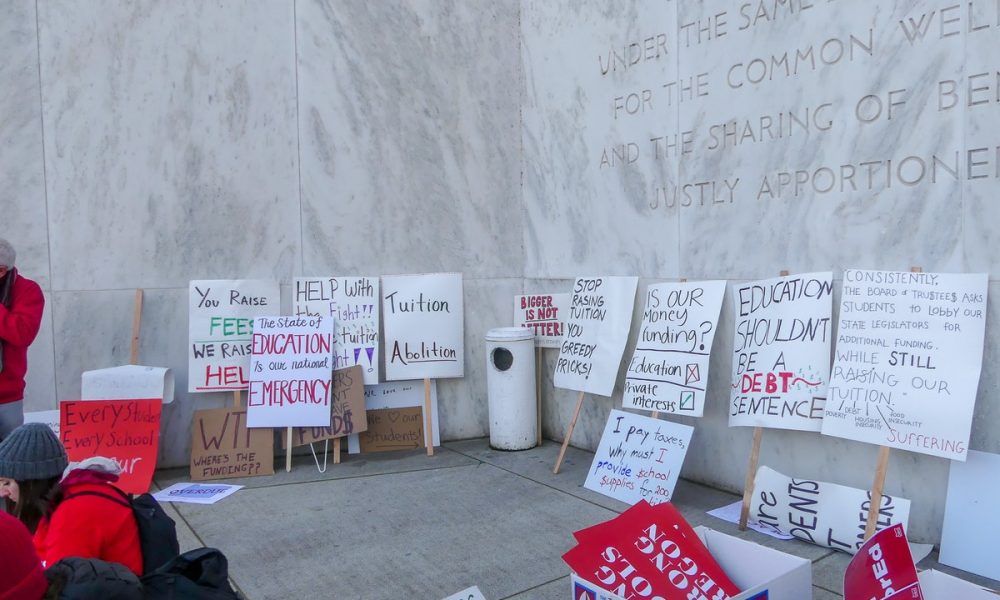
Rally signs from Oregon educators line the Capitol during the February 18, 2019 March for Our Students. (Rachel Alexander/Salem Reporter)
SALEM — A $1 billion-per-year tax plan to boost education cleared a major procedural hurdle in the Capitol Monday — and it got a big political boost in the process.
The legislation, House Bill 3427, goes to the House following Monday evening’s party-line vote in the Joint Student Success Committee.
The milestone follows more than a year of work by the committee to seek ways to improve local schools and find the money to do so. The bipartisan group of lawmakers visited school districts across Oregon, hearing from students, parents, teachers, administrators and support staff.
Among the goals of the new spending is to increase the number of students graduating from high school and improving reading in elementary schools throughout Oregon’s 197 school districts, which serve about 580,000 students.
Jim Green, executive director of the Oregon School Boards Association, said the Student Success Act has drawn more interest than any education-related bill he can recall since the early 1990s, when the state pushed smaller districts to unify.
“This is a huge investment,” he said.
Oregon schools are among the worst performing in the nation, data collected by the U.S. Department of Education indicates.
Within the continental United States, only New Mexico and Washington, D.C., graduate a smaller percentage of their high school students on time. Oregon also ranks poorly in school attendance and instructional time.
State Sen. Arnie Roblan, D-Coos Bay, spent about three decades working at Marshfield High School, first as a math teacher and later as a principal.
“I watched the slow erosion of the opportunities that kids have, from the time I started back in the early 1970s to the time when I left in 2005,” said Roblan, who co-chaired the Student Success Committee. “Even after that, we’ve had population growth. We’ve had less money available for schools. So the things that were just common-sense offerings before have gone away. The class sizes have gotten bigger.”
The state currently allocates $8.2 billion in the 2017-2019 budget to the state school fund, which pays school districts on a per-student basis. A state commission said last year that amount should be closer to $10.7 billion in the 2019-2021 budget to pay for a “quality education model.”
Instead of just adding to the school fund, however, the Student Success Act sets up what it calls student investment grants. The idea is to provide money for school districts across the state that show they will spend it on certain needs that committee members identified as important.
Roblan and Rep. Barbara Smith Warner, D-Portland, the committee’s other co-chair, said one of the biggest priorities they heard during their tour of the state was behavioral health. School districts that receive student investment grants are expected to put part of that money toward meeting those health needs, as well as toward academics.
Student investment grants could be used to improve health and safety in schools, a broad category that encompasses behavioral health. Aging schools with health hazards — asbestos, for instance — could also use state money to upgrade their facilities.
Increasing instructional time is another allowable use of grant money. That could mean longer school hours, more school days or summer classes, to name a few.
Many school districts are struggling with large class sizes, which have swollen into the 40s at some schools due to budget cuts. Districts could use grants to reduce class sizes, such as by adding instructional assistants to alleviate teachers’ workloads.
The act also provides more money for arts and music classes, physical education, life skills courses, college preparation, and career and technical education, among other “well-rounded learning experiences.”
To get an award, districts and state officials would have to agree on how the money would be used and measure its effectiveness.
“We’re giving school districts a lot of latitude on how they want to spend that,” Roblan said.
Smith Warner said the state takes the blame when schools underperform, she noted, and she wants to ensure that the new money goes where it’s most needed.
“We are held accountable, to some extent, for what the districts are doing,” said Smith Warner, the Student Success Committee’s co-chair. “We’re trying to find a middle ground between, ‘Here, just spend this all how you see fit’ … and, ‘Everybody have your class sizes that are this, everybody have these instructional hours, everybody have the same seven classes that are this.’”
In extreme cases, a limited number of school districts where students are lagging behind the rest of the state could participate in a four-year intensive program. They would get more money and advice from experts on how to spend it. They would have to follow those recommendations and report progress.
Smith Warner prefers the targeted approach over putting more money into the state school fund.
“We actually have very little ability to tell those school districts how to spend that state school fund money,” she said, adding, “The idea is that we want to do a version of ‘outcome funding.’”
Christy Perry, superintendent of the Salem-Keizer School District, said the accountability mechanisms seem reasonable for school districts.
“If it really helps the Legislature feel like they can invest in education, it’s worth it,” she said.
The infusion of money would also provide full funding for Ballot Measure 98, which voters approved in 2016 to expand career and technical education at high schools. Oregon has faced criticism for not meeting the voter-approved level of $800 per high school student since the measure’s passage.
The bill requires the Oregon Department of Education to fund the measure at the prescribed level.
Morgan Allen, deputy director of policy and advocacy for the Confederation of Oregon School Administrators, said Measure 98 funding would be especially helpful in smaller districts.
“It’s a little bit harder sometimes in smaller districts, because the welding equipment costs the same and the economies of scale are hard to achieve,” he said.
Other initiatives include supporting local programs to reengage high school dropouts, keep students on track to graduate, and counter harassment and bullying in schools.
The Student Success Act also allocates about one-fifth of the new money to early learning programs, such as preschool, pre-kindergarten, and special programs for developmentally and behaviorally challenged children.
Brown had pressed legislators to also find money for community colleges and financial aid, but she backed off that demand last week, saying she will focus on the budget process instead. The Legislature is tasked with producing a 2019-2021 budget by the end of June.
“I will continue to fight to make sure that … there are adequate resources for my priorities of ensuring that higher education is affordable and accessible to Oregonians,” Brown said.
The education package is fueled by a corporate activity tax. The tax would be levied on businesses with sales of at least $1 million per year in Oregon. Businesses would have to pay 0.57% of their gross receipts over $1 million to the state, although they would be able to deduct up to 35% of their labor or production costs, whichever is highest.
In a surprise development, a major business lobby that had criticized the gross-receipts tax proposal declared it would be neutral before Monday’s committee vote.
Sandra McDonough, president and chief executive officer of Oregon Business & Industry, said the group shares the committee’s goals and won’t fight the tax proposal.
“We feel comfortable with the direction that this conversation is going,” McDonough told committee members.
To dampen the impact on consumers, legislators exempted grocery and fuel from the new tax.
Many individual taxpayers would get a break as well. The personal income tax rate for all but the top bracket would be trimmed by a quarter-percent under the plan.
For Roblan, the Student Success Act represents something of a crowning achievement.
“I believe this is the 30-year-late response to Measure 5,” Roblan said.
Voters approved Ballot Measure 5 in 1990, slashing the amount of money that school districts get from property taxes in Oregon. The Legislature was expected to come up with another funding source, Roblan said, but it didn’t — until now.
“It’s time to live up to that commitment,” Roblan said.
Because it raises taxes, the bill needs at least 36 out of 60 House members to approve for it to pass. Democrats have 38 seats. It faces a sterner test in the Senate, where Democrats hold 18 seats and will need 18 senators to pass the bill.
None of the Student Success Committee’s Republican members, including its vice chairs, Rep. Greg Smith of Heppner and Sen. Tim Knopp of Bend, voted for the Student Success Act on Monday.
Reps. Cheri Helt, R-Bend, and Sherrie Sprenger, R-Scio, said they support investing in education but have serious concerns about how businesses will be taxed to pay for the new tax. Sens. Kim Thatcher, R-Keizer, and Chuck Thomsen, R-Hood River, also voted no.
Roblan and Smith Warner were joined in support by eight Democrats: Reps. Brian Clem of Salem, Julie Fahey of Eugene, Diego Hernandez of Portland, John Lively of Springfield and Nancy Nathanson of Eugene, and Sens. Lew Frederick of Portland, Mark Hass of Beaverton and Kathleen Taylor of Milwaukie.
Reporter Mark Miller: [email protected]. Miller works for the Oregon Capital Bureau, a collaboration of EO Media Group, Pamplin Media Group, and Salem Reporter.
Rachel Alexander contributed reporting.




